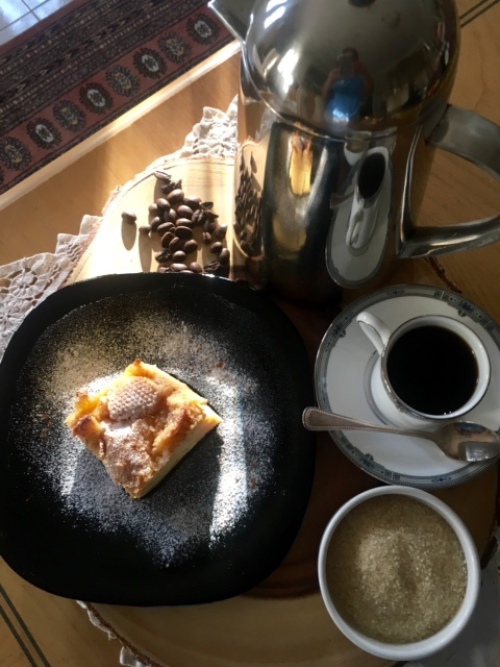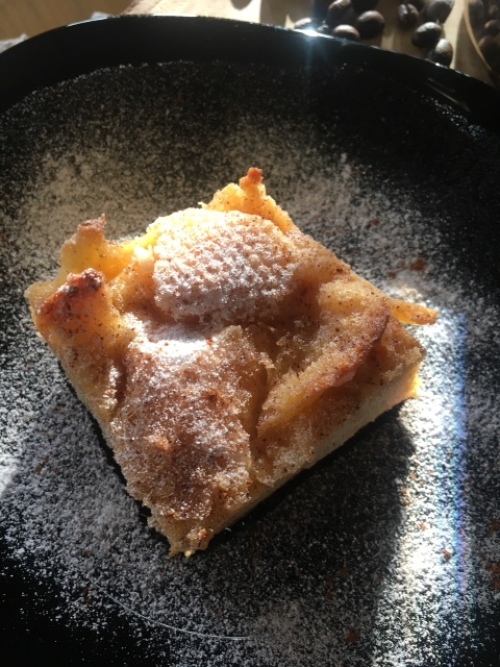
Anyone who knows Haiti or Haitians knows that coffee is synonymous with this culture. Arabica Coffee is grown in the Haitian mountains at high altitudes and the beans are roasted artisanally all over the country by locals for consumption by Haitians from all walks of life. “Bonjou, koumen nou ye? Ou vle yon ti kafe?” “Good morning, how are you? Would you like some coffee?” is a common greeting everywhere. In offices, homes, at meetings, and even at hair salons… there is always someone with a tray in hand serving steaming coffee in little demi-tasse cups. Here, coffee is robust, dark, strong and sweet! Milk is not commonly served with coffee in Haiti, but when it is, it is called a “cafe au lait”. Even young children are given cafe au lait as part of their morning breakfast. A good jolt of caffeine is enjoyed by many to start the day.
Ethiopia was most probably the birthplace of the coffee bean. The earliest text mentioning coffee was from an account from by a cleric from the Sufi monasteries of Yemen in about the 15th century. Coffee was used in the Middle East, Persia, Turkey, the Horn of Africa and North Africa. Eventually, coffee usage expanded to the Balkans, Italy and the rest of Europe. With trade routes and commerce, coffee arrived in South East Asia and then on to the Americas. The Coffee Bean lured people, who quickly became addicted to this little bean and its effervescent effect on our system.
A Yemenite Sufi mystic was said to have observed birds eating berries from a shrub. He noticed a vibrancy and vitality of the species after they had consumed them. Bewildered by the reaction, he decided to try the berries himself, and he too found himself vitalized after chewing on the bitter berries. The method of roasting the beans, grinding and making a beverage, was adopted by mystics and monks to help with concentration and alertness during their night-time rituals.
The Turks were renown for their coffee-making skills. They served the beverage with sugar.The Ottoman Empire was the gateway to Europe, thus inevitably introducing the method to the continent. The Coffee Houses of Europe became very fashionable in the 17th century. It was then that the addition of milk was acquired to the hot beverage. The Austrians made Viennese coffee which was coffee served with sugar and steamed foamy milk. They were the original ancestors of today’s Starbucks. The Europeans love of fashion and culture created a coffee culture all over Europe. Coffee was sought widely as was its famous accompaniment…Sugar!
Coffee was first planted in the Americas in Martinique around 1720. From here, it spread to St. Domingue (modern-day Haiti and the Dominican Republic). Between the years of 1734-1788, half of the world’s coffee was grown on the island. The high altitude of Haiti’s vast mountains as well as its climate made it the perfect terrain for Coffee to grow. This became a huge cash crop for St. Domingue and cemented the use and coffee culture which we know and enjoy today. Coffee and sugar commodities were in high demand in Europe. The ravenous appetite for these items required an equally massive labor force to sustain the demand. This fact encouraged and established the slave trade between Africa and the Caribbean, and brought our African ancestors trans-continental to labor in the plantations and fields. The coastal city of Jacmel became a very prestigious Port for coffee export to Europe in the heyday of coffee.
The Haitian revolution of 1804 brought freedom and established Haiti as the first Black Republic and free nation in the Americas. The “Mother of the Americas” was born, but with this claim of freedom, the end of the majestic period of Sugar and Coffee as King of this region also came. Haiti was never able to retain its massive productivity or its coffee and sugar trade efficiently to Europe. The new nation was blacklisted and boycotted for fear of the new republic spreading the seeds of revolution to neighboring slave colonies.The price of Freedom was great.
The coffee culture here was established a few centuries ago, and perhaps overlooked or unknown to most are the once grand beginnings of this cash crop. Often in the countryside on the early morning, you can smell a wood fire burning and the fragrant aroma of coffee beans being roasted on the open fire pit. Nearby, you will hear the pounding of the mortar and pestle (pilon), and you know that some good coffee will be made soon. Fresh coffee offers respect, amicable relations and a good dose of vitality to those who partake.
I am adding my recipe for Cinnamon Toasted Bread Pudding. It is a lovely decadent brunch or breakfast offering. It goes perfectly with a cup of coffee or tea and I am sure that you will love it.
Cinnamon Toasted Bread Pudding
Serves 6
1/2 French loaf ( baguette) 1 day old; sliced
4 eggs,
1 14oz can sweetened condensed milk
1/2 tsp vanilla
1/8 tsp salt
1/2 tsp ground cinnamon
2 tbsp melted butter
1 tbsp rhum or amaretto
1 1/2 cups water
Topping
1 tbsp brown sugar, 1 dash of cinnamon, some grated nutmeg and 1 tbsp butter cut into small pieces.
Method
Preheat oven to 350 degrees
Slice bread into 1/4″ pieces and then cut each slice into 4 pieces. Place on a baking sheet to dry while you prepare the custard.
In a large bowl, beat eggs well.
Add the sweetened condensed milk, water, salt, cinnamon, vanilla and rhum to the beaten eggs.
Add melted butter.With an emulsion blender or whisk, beat this mixture well. Add the bread to the egg custard and ensure that all pieces absorb the liquid.
Generously butter a 9″x 6″ pyrex dish or baking pan.
Pour the bread mixture into the prepared pan. Sprinkle with brown sugar and a dusting of cinnamon powder and a grating of nutmeg. Dot the surface with small pieces of butter
Bake in a prepared oven for 30 minutes or until bread pudding is golden brown.
Note: if you like, 1/4 cup raisins may be added to the pudding before pouring into baking pan. This pudding may be served hot or cold.
Serve warm as it puffs up and a delicious aroma fills the air. The top will also be toasty with the sugar crystals and cinnamon.
I’ve never developed the taste for coffee, I don’t necessarily dislike it but I just can’t seem to capture the essenes of it maybe because the ones sold in the states to the general market aren’t that great. I’ve never had coffee from Ayiti but by they way you’ve described it being enjoyed by Haitians and the fact that my parents to tell me that coffee in Haiti can’t be compared to the one sold here has my mouth watering in anticipation to have my first cup of café lakay.
I am a tea drinker, but I do have a cup of Haitian coffee every now and again. I make Haitian coffee at home every morning for my husband and son and as the delicious aroma fills the air, I know that it’s good. You should definitely try Haitian blue mountain coffee. You can find café Selecto or Rebo which are available in the USA or even on-line.What your parents have said is true about café lakay!! Come visit the country sometime and learn about the traditions here.